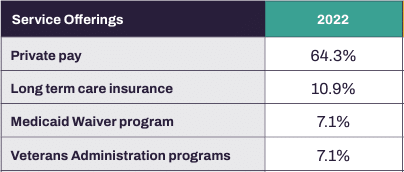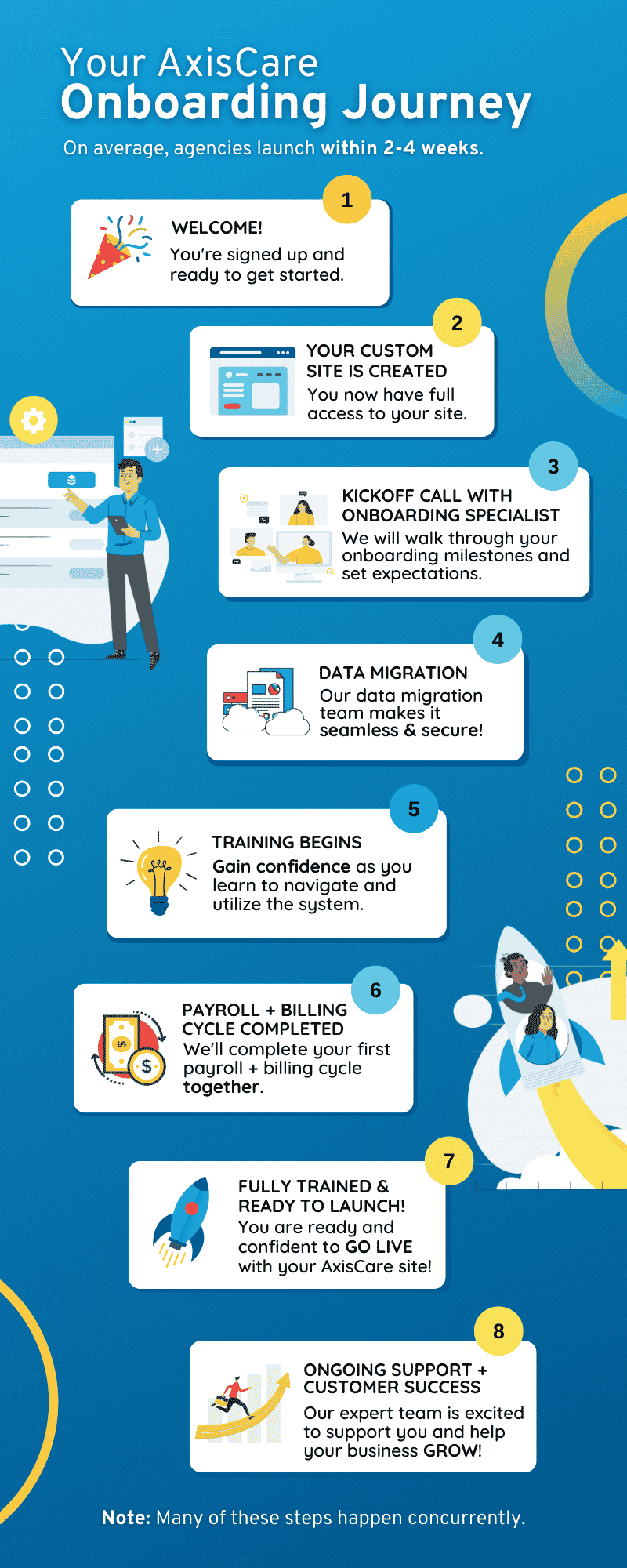Finding new ways to deliver home care is the million-dollar question for 2023. Better training and technology are key for home care agencies’ success, and this year is looking very promising due to an upward trend in demand for in-home care. Encouraging home care statistics show that the home care industry has seen consistent growth throughout the past decade, and that growth is not forecasted to change any time soon.
According to the 2023 Activated Insights Benchmarking Report by Activated Insights, the home care industry has experienced a median revenue increase of $52,192 in the past year, making it the highest annual increase in the last four years. This growth is a clear indication of the industry’s expanding customer base and nationwide need for care. Additionally, the median growth rate for home care customers is 6.1%, which is a return to pre-pandemic levels, and suggests a positive outlook for the industry’s future.
Download your copy of The Future of Home Care: A 2025 Survey of the Home Care Industry & Future Trends for more data and insights.
Current State of Home Care
The home care industry is a dynamic and rapidly evolving field, with new challenges and opportunities consistently arising. One of the key home care industry trends to improve healthcare is the use of technology with home care software to ease the workload of caregivers and improve the quality of care administered. Despite the challenges, the home care industry is constantly adapting to meet the needs of its clients and provide high-quality care. It is an exciting time for the industry, with many positive developments on the horizon.
Aging Population
The global population is aging, with a growing number of seniors needing assistance with daily activities. According to the World Health Organization, by 2030, 1 in 6 people in the world will be aged 60 years or older.
Preference for Aging in Home
Many individuals prefer to receive care in the comfort of their own homes rather than moving to long-term care facilities. Market.us Media reported that each year, approximately 12 million Americans receive home health care services.
Government Support
Governments worldwide have recognized the benefits of in-home care and have implemented policies and funding initiatives to promote home-based care services.
Workforce Challenges
The home care industry faces workforce challenges, including a shortage of caregivers. Activated Insights 2023 benchmarking reported that caregiver shortages are the top threat facing home care providers in 2023.
Growth and Demand for Home Care Services
According to Market.us Media, the number of home care agencies in the United States is on the rise, with about 33,200 reported in 2022. The U.S. Bureau of Labor Statistics reported that the demand for home health care and personal care aides is expected to rise by 34% from 2019 to 2029, surpassing the average growth rate of all occupations.
Reliable Home Care Market Growth
The United States is contending with a continually declining birth rate and an aging population. By 2034, there will be more adults over the age of 65 than children under the age of 18. Between 2018 and 2060, the population of seniors will have nearly doubled.
This, of course, is good news for the home care industry.
The industry is already one of the fastest expanding industries in health care. Last year, U.S. home care spending reached an all-time high of $113.5 billion, and in 2021, there will be approximately 9,000 more home care agencies than there were five years ago.
Patient Preferences for Home Care
A recent study conducted by The Associated Press-NORC Center for Public Affairs Research found that 88% of Americans would rather receive any necessary long-term care services in the comfort of their own homes as they age.
Customer Preferences for Aging Care
The National Center for Biotechnology Information states: “When asked about their care preferences, older Americans overwhelmingly articulate a desire to age in place and receive care at home rather than in institutional settings.”
While the extreme streamlining of hospital patients will eventually subside, the number of people who prefer in-home care (either through affordability, safety, convenience, or quality of care) is likely to remain.
Thankfully, receiving care in the comfort of one’s own home is no longer an anomaly. It is likely to become the health industry’s top focus.
Costs Involved in Home Care
The median cost of in-home health care varies by state, but according to a survey by Genworth Financial, the national average is around $4,000 per month.
Home Care Affordability
Home care services can sound expensive, but in most cases where 24/7 assistance isn’t a requirement, it is often the best, most affordable option.
Even more encouraging is the recent increase in home health insurance coverage and the rising demand of home care.
Medicare Advantage organizations have added in-home support services to even more plans in 2023, with 1,091 plans having them now, compared to 729 in 2022, 429 in 2021, and 223 in 2020.
“Prior to 2019, non-medical home care agencies did not have a role in the Medicare Advantage landscape. After a variety of policy changes, they now have an opportunity to contract with MA plans through two major pathways.” (Home Health Care News)
Home Care Workforce
Activated Insights Benchmarking Report revealed that in 2022 the historical median professional caregiver turnover rate for home care was 77.1%, and Indeed.com was the top home care professional caregiver recruitment source/method in 2022. HCP also reported that the overall percentage of agencies that consistently turned down cases due to professional caregiver shortages as of January 2023 was 53.8%.
For best practices in writing job descriptions and recruiting new caregivers check out our free resource: A Guide to Finding, Recruiting, and Retaining Your Perfect Caregiver
Home Care Quality and Outcomes
Only 25.1% of home care providers were tracking hospital admission rates in 2022, showing room for improvement in 2023 for tracking hospitalization metrics.
“In the United States, there are over 45M seniors. Of this population, based on Medicare stats, we know that approximately 15M of these individuals will end up going to the hospital every year. We also know that of this 15M, 3M suffer from five or more chronic conditions, and will be hospitalized several times this year.” (Activated Insights)
Home care software helps caregivers keep track of clients’ activities, including cases where hospitalization is needed. Caregivers can improve the quality of service they provide to their clients by using home care software that simplifies the process of taking notes and tracking tasks during a shift.
Insurance Coverage for Home Care
Home care agencies in 2022 relied primarily on private pay, which accounted for 64.3% of their revenue. Home care agencies generated 10.9% of their revenue from long-term care insurance, while the Medicaid Waiver program and Veterans Administration programs each accounted for 7.1% of their revenue. (Activated Insights)
Government Involvement in Home Care
Home Health Care News reported that home care agencies were focused on a payment rule proposal from the Centers for Medicare & Medicaid Services (CMS) after COVID-19 subsided. Although CMS didn’t implement its proposed cuts for 2023, it plans to recover billions in perceived Patient-Driven Grouping Model (PDGM) overpayments and make permanent rate adjustments. Agencies and CMS disagree on whether home care agencies are overpaid, and agencies need to prepare for potentially unsteady payment from fee-for-service Medicare.
Technology and Innovation in Home Care
Home care agencies rely on home care software to efficiently manage their daily operations. This software employs sophisticated algorithms to analyze caregiver and client profiles, matching them based on various factors, including skills, personalities, and preferences. It even takes into account specific details, such as allergies to pets, to ensure the perfect match between caregivers and clients. This enables schedulers to make timely and appropriate selections, ensuring quality care for clients. Home care agencies faced a 50.2% median customer turnover rate in 2022. To improve client retention, it’s crucial for agencies to use home care scheduling software to ensure that caregivers are consistently matched with clients.
The Evolution of Home Care Through Technology
Home care softwares, like AxisCare, have empowered agencies to be more efficient and organized during a time when quality of care is more important than ever.
Technology has infiltrated everything—including otherwise non-technological jobs. Many caregivers already use scheduling and management software to log essential visit information and check schedules. This technological proficiency has helped keep operations fluid.
Moving forward, tech will become a more prominent and essential tool for home care agencies, for both quality of care and compliance with new rules and regulations.
Technologies such as Telehealth, caregiver mobile apps, and robust scheduling and management softwares will play an important role in ensuring that these different types of care and services are possible and documented with accuracy.
The bottom line is that technology is safe, allowing increased flexibility for both caregivers and clients, and will continue to be a positive, long-term advancement in the home care landscape.
A Bright Horizon
Home care services are important for helping older adults maintain their independence and quality of life. Technology, including home care software, plays a crucial role in improving the delivery of care and making it more efficient. Customizable health care software, like AxisCare, can help manage record keeping, scheduling, billing, and visit verification processes.
Stay Ahead of Statistics with AxisCare’s Tailored Solutions
It is an exciting time for the home care industry as it is experiencing and forecasting rapid growth. AxisCare has been proactive in staying ahead of technological advancements and innovation to best serve agency owners and offers customizable software to fit the needs of home care agencies. Don’t miss out on this opportunity to streamline your operations. Book a demo with AxisCare today.










